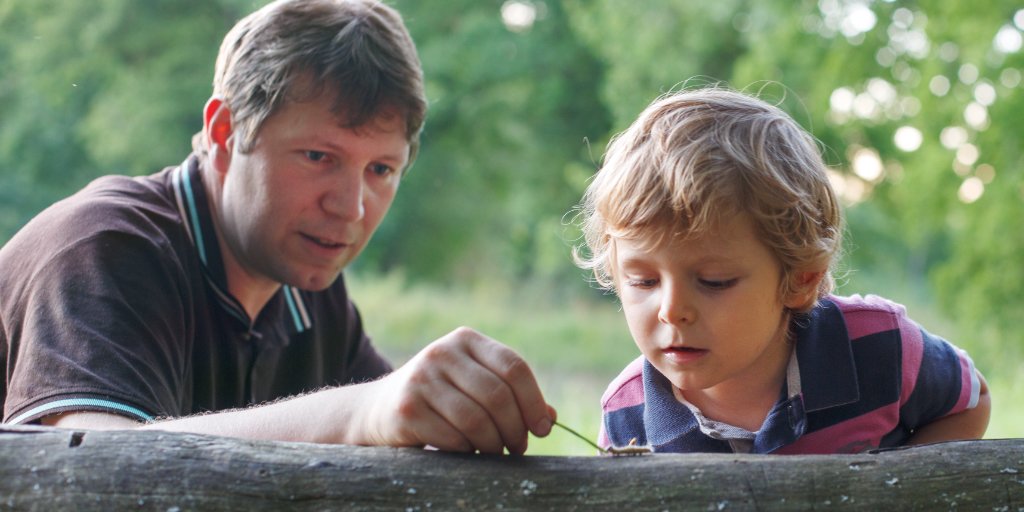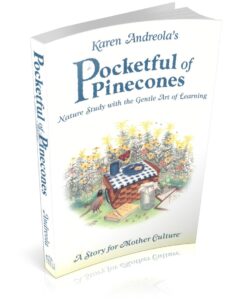60-day returns • free shipping on USA orders $129+
So far in this series we’ve talked about all the great benefits that we and our children can gain from doing nature study. We’ve also addressed Charlotte Mason’s encouragement to get outside one half-day per week, all year round.
That all sounds great, but sometimes there is confusion about what to do once you step outside that door. What should nature study look like?
Here is a lovely description that Charlotte gave in School Education, page 237.
“On one afternoon in the week, the children (of the Practising School) go for a ‘nature walk’ with their teachers. They notice for themselves, and the teacher gives a name or other information as it is asked for, and it is surprising what a range of knowledge a child of nine or ten acquires. The teachers are careful not to make these nature walks an opportunity for scientific instruction, as we wish the children’s attention to be given to observation with very little direction. In this way they lay up that store of ‘common information’ which Huxley considered should precede science teaching; and, what is much more important, they learn to know and delight in natural objects as in the familiar faces of friends. The nature-walk should not be made the occasion to impart a sort of Tit-Bits miscellany of scientific information. The study of science should be pursued in an ordered sequence, which is not possible or desirable in a walk. It seem to me a sine quâ non of a living education that all school children of whatever grade should have one half-day in the week, throughout the year, in the fields. There are few towns where country of some sort is not accessible, and every child should have the opportunity of watching, from week to week, the procession of the seasons.
“Geography, geology, the course of the sun, the behaviour of the clouds, weather signs, all that the ‘open’ has to offer, are made use of in these walks; but all is incidental, easy, and things are noticed as they occur. It is probable that in most neighbourhoods there are naturalists who would be willing to give their help in the ‘nature walks’ of a given school.”
From that passage, let’s draw some key principles to help guide your nature study.
- Once a week, go on a nature walk with your children.
- Notice things as they occur. Encourage the children to watch patiently and quietly for themselves “until they learn something of the habits and history of bee, ant, wasp, spider, hairy caterpillar, dragon-fly, and whatever of larger growth comes in their way” (Home Education, p. 57). Nature study should not be a staged, formal science lesson.
- Give additional information as a child is ready for it. Be ready to offer related information in the moment of discovery. If your child is observing a bumble bee within a patch of flowers, that is a prime opportunity to casually mention pollen and ask if the child can see any on the bee’s legs. Now, don’t panic and think that you can’t do nature study until you know all about everything outside. If your child asks about something and you don’t have the answer immediately, that’s okay. You now have a wonderful opportunity to do some research together and continue the excitement of learning about nature after you go back indoors.
- Your goal is that the child will “learn to know and delight in natural objects as in the familiar faces of friends.”
- Watch the procession of the seasons from week to week.
- The weather, clouds, rocks, the course of the sun, and the lay of the land are all appropriate items to include in nature study, as are wild flowers, trees, creatures—all natural objects near your home.
- If desired, invite a knowledgeable friend to accompany you on your nature walks to provide information that you may not know as your child requires it.
And, of course, don’t overlook those spontaneous opportunities that arise amid your everyday life. My daughter and I just returned from the library where she noticed an earthworm on the sidewalk, trying to get back to the moist earth. We stood and watched that worm for quite a while. Such a delightful pause in our day!
Now, you might have noticed that Charlotte promoted nature study in a rural setting. It makes sense that there is more nature to observe in the country as compared to in the city, but that is not to say that you can’t do nature study if you live in a city. There are still plenty of opportunities to find natural objects that you can “learn to know and delight in.”
You could
- Look at clouds and notice the weather
- Get to know the trees in your yard
- Observe pets
- Take a field trip to a pond (or a farm)
- Observe insects, such as ants, flies, crickets, and spiders
- Watch sparrows or attract other local birds with a bird feeder
- Watch the growth of flowers (You can always plant some yourself.)
- Adopt a swarm of bees in your backyard
- Visit any nearby streams
- Create a butterfly-friendly backyard
- Plant a container garden of herbs
Nature is all around us. We have only to pause and look intentionally to benefit from it.
Karen Andreola has written a delightful living book that allows you to follow one family as they do nature study: A Pocketful of Pinecones. Parents will learn a lot about what nature study looks like by reading this story and will be inspired to “go and do likewise.” (Note: A Pocketful of Pinecones is designed to be an enjoyable instructional book for parents, not to use as a read-aloud to the children.)
Next time we will discuss the nature notebook and how you and your children can record the observations you make as you go on your nature walks.
Podcast: Play in new window | Download



Most of our nature experiences find us! We pray for it! Living in the city and in a suburb, it is challenging to experience nature the same way as my more northern friends who even have different seasons.
While planting some new flowers along the front of our house, (I wish I could remember what they are!!!), all of a sudden we had a snail invasion. The snails only attacked the flowers with the purple blooms! We tried a couple of homemade remedies like salt to get the snails off the flowers, but had to resort to some store bought powder. That was such a learning experience for us.
Also, two years ago, we bought a mulberry bush hoping to attract birds. Because of our neighbor’s 10 cats, we don’t get any birds, but we have found a peculiar beetle we have never seen before. As far as we know, this beetle has never been spotted in our yard till now. Our goal is to identify it. But how did it “find” it’s host tree? That’s amazing.
We rescued a baby dove and I really thought the little thing would not make it. But we have been feeding it “baby bird formula” and watching all his developments. (I call it a “he” but don’t know). We have seen his feathers come in, he’s walking now, and he just started perching. What an up close nature experience!
We have collected shells from our various trips to the beach, and on rainy days, I’ve thought to get them out with a field guide and have the children identify them.
When it’s too hot to be outside during the day for much, there’s always meteor showers to look at! I’m trying to get more creative with night nature study!
So, my point is to take advantage of what the Lord places in your lap. If I would just do that, we would have so much to do outside. We try very much to bring nature to us with bird feeders and plants. That really makes nature study almost effortless. But for me, it takes “eyes” to appreciate it and take advantage of it.
Grace & Peace,
Betty
We have a woods and creek behind our house. The kids LOVE exploring there for hours. They find frogs and lizards frequently, and tons of fossils, rocks and crystals. We have spent time collecting leaves for identification and rubbing. And we love going for long hikes. We also greatly enjoy bird watching in our backyard. We have several feeders and a guide handy at our window for naming our feathered friends.
Sincerely,
Deborah in KY
This series is so incredibly helpful. Thank you for laying this out so simply! I am just diving in to CM’s methods and sometimes it’s hard to know how to practically apply them! The way this post in particular ‘translates’ the passage from CM’s own words really helps! Thank you!
We love going in Nature walks!!! I would like to know about the nature apps Sonia mentioned in the smart phone article, so I can use them!!! Thank you!!!
The nature field guide app Sonya talked about in the smartphone article is Merlin Bird ID from Cornell.